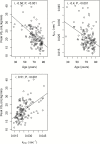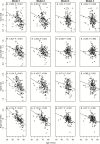31P Magnetic Resonance Spectroscopy Assessment of Muscle Bioenergetics as a Predictor of Gait Speed in the Baltimore Longitudinal Study of Aging
- PMID: 27075894
- PMCID: PMC5106855
- DOI: 10.1093/gerona/glw059
31P Magnetic Resonance Spectroscopy Assessment of Muscle Bioenergetics as a Predictor of Gait Speed in the Baltimore Longitudinal Study of Aging
Abstract
Background: Aerobic fitness and muscle bioenergetic capacity decline with age; whether such declines explain age-related slowing of walking speed is unclear. We hypothesized that muscle energetics and aerobic capacity are independent correlates of walking speed in simple and challenging performance tests and that they account for the observed age-related decline in walking speed in these same tests.
Methods: Muscle bioenergetics was assessed as postexercise recovery rate of phosphocreatine (PCr), k PCr, using phosphorus magnetic resonance spectroscopy (31P-MRS) in 126 participants (53 men) of the Baltimore Longitudinal Study of Aging aged 26-91 years (mean = 72 years). Four walking tasks were administered-usual pace over 6 m and 150 seconds and fast pace over 6 m and 400 m. Separately, aerobic fitness was assessed as peak oxygen consumption (peak VO2) using a graded treadmill test.
Results: All gait speeds, k PCr, and peak VO2 were lower with older age. Independent of age, sex, height, and weight, both k PCr and peak VO2 were positively and significantly associated with fast pace and long distance walking but only peak VO2 and not k PCr was significantly associated with usual gait speed over 6 m. Both k PCr and peak VO2 substantially attenuated the association between age and gait speed for all but the least stressful walking task of 6 m at usual pace.
Conclusion: Muscle bioenergetics assessed using 31P-MRS is highly correlated with walking speed and partially explains age-related poorer performance in fast and long walking tasks.
Keywords: Bioenergetics; Lower extremity performance; Magnetic resonance spectroscopy; Muscle; Walking speed.
Published by Oxford University Press on behalf of The Gerontological Society of America 2016. This work is written by (a) US Government employee(s) and is in the public domain in the US.
Figures



References
-
- Halter J, Ouslander J, Tinetti M, Studenski S, High K, Asthana S. Hazzard’s Geriatric Medicine and Gerontology. 6th ed New York: McGraw-Hill Education; 2009.
-
- Studenski S, Perera S, Wallace D, et al. Physical performance measures in the clinical setting. J Am Geriatr Soc. 2003;51:314–322. - PubMed
-
- Fiser WM, Hays NP, Rogers SC, et al. Energetics of walking in elderly people: factors related to gait speed. J Gerontol A Biol Sci Med Sci. 2010;65:1332–1337. doi:10.1093/gerona/glq137 - PubMed
Publication types
MeSH terms
Substances
Grants and funding
LinkOut - more resources
Full Text Sources
Other Literature Sources
Medical

